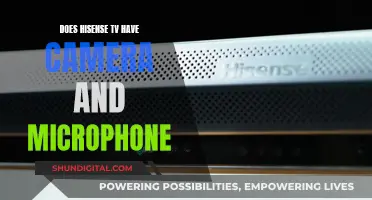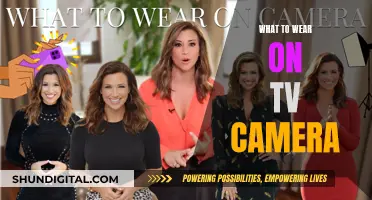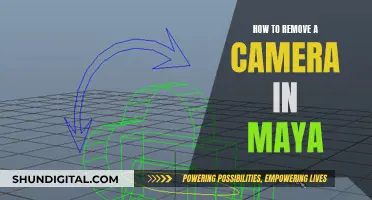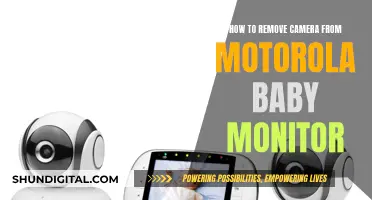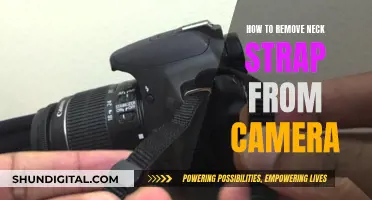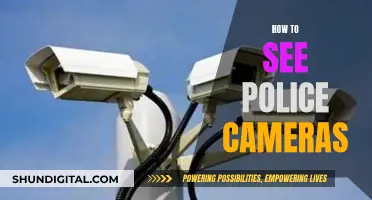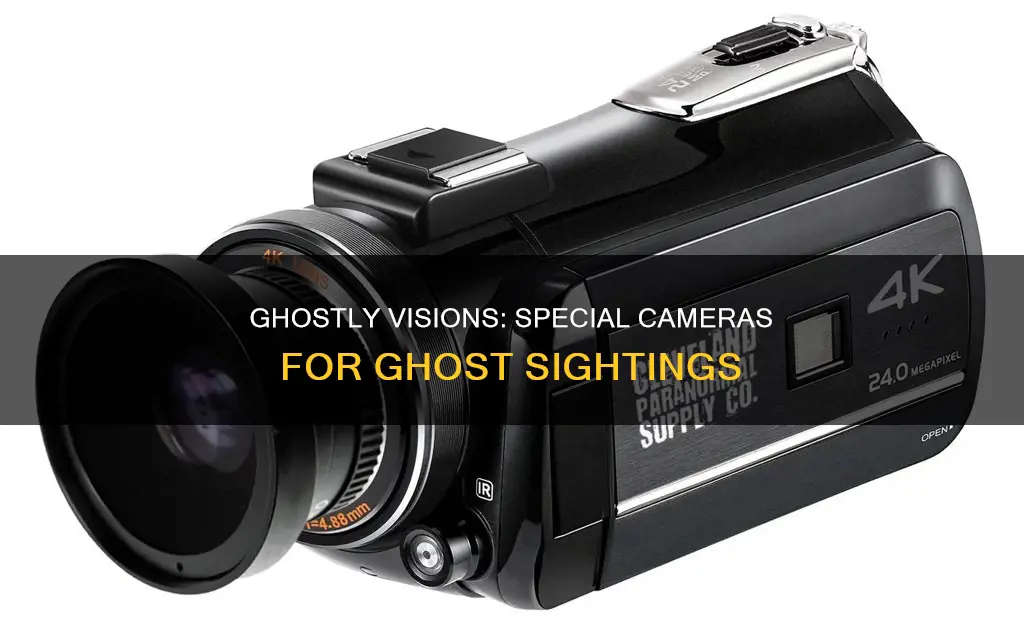
The existence of ghosts is a highly debated topic, with many people claiming to have seen or experienced paranormal activity. While there is no scientific evidence to support the existence of ghosts, some people believe that certain cameras can be used to detect or capture images of ghosts. These cameras are typically modified to capture a broader spectrum of light, including infrared and ultraviolet light, which are believed to be outside the range of human vision. Some people also believe that ghosts may be detected using thermal imaging technology, which can identify cold spots or heat signatures that could indicate a supernatural presence. However, it is important to note that there is no scientific consensus supporting the existence of ghosts, and many purported ghost sightings can be attributed to technical abnormalities, reflective surfaces, or other explainable phenomena.
What You'll Learn

Ghost-hunting tips for thermal cameras
Thermal cameras are an increasingly popular tool for ghost hunters, as they can identify temperature changes that may indicate paranormal activity. Here are some tips for using thermal cameras for ghost hunting:
- Understand the technology: Familiarise yourself with how thermal cameras work. They use infrared radiation, which is invisible to the human eye, to detect heat emitted by objects and create a visual representation. This is different from regular cameras, which capture visible light.
- Choose the right camera: Select a lightweight, handheld thermal camera or a smartphone attachment. Handheld models may offer a wider temperature range and greater sensitivity. Reputable brands include FLIR, Hikmicro, and Fluke.
- Conduct a baseline scan: Before investigating, take thermal images of the environment without any suspected ghostly activity to establish normal temperature variations. This will help you distinguish them from any anomalies that may appear during your ghost hunt.
- Be aware of reflections: Reflections and mirages can create illusions that may be mistaken for ghosts. Always analyse your surroundings and consider alternative explanations before concluding that you've spotted a ghost.
- Account for human presence: People leave behind heat signatures, so track your movements and those of your team to avoid mistaking them for paranormal activity.
- Consider natural variations: Drafts, insulation issues, and weather conditions can cause temperature changes that may be misinterpreted as ghosts. Always investigate all possible explanations before concluding that a temperature anomaly is supernatural.
- Document and compare findings: Take detailed notes, capture images or videos, and record temperature readings. Collaborate with other ghost hunters to share experiences and compare findings for a more objective assessment.
- Use additional equipment: Don't rely solely on thermal cameras. EMF meters, digital voice recorders, and motion sensors can provide additional data for a more comprehensive understanding of potential paranormal activity.
- Prioritize safety: Ghost hunting can be risky, so always put your safety first. Bring a team and be aware of potential physical dangers from unscrupulous individuals or other hazards.
- Check reviews: Research consumer reviews to find a suitable thermal camera that fits your budget.
Troubleshooting Nightowl Cameras Not Showing on TV
You may want to see also

Security cameras capturing ghosts
Ghost photography has been around for almost as long as cameras have existed. In the past, ghost sightings on camera were often the result of multiple or long exposures, or other photography tricks. The gritty, grainy, low-budget nature of early photography made these images seem more authentic.
Today, there are numerous reports and videos of alleged ghost sightings on security cameras. From a ghost playing on stairs to a ghost with glowing eyes, these videos can be convincing. However, it's important to approach these videos with a degree of skepticism. In many cases, ghost sightings on security cameras can be attributed to a number of factors, such as:
- Glare from dirt, shadows, smudges, bugs, or other objects on the camera lens.
- Improper camera settings, such as slow shutter speed, high gain, or high DNR.
- Reflections or mirror images that appear ghostly.
- Video editing and special effects that can easily manipulate footage.
- Natural phenomena, such as shadows or reflections, that can be mistaken for ghosts.
While security cameras can capture eerie footage that sparks curiosity and imagination, it's important to remember that there are often rational explanations for these occurrences.
Viewing Through Your Camera's Eyes on Windows
You may want to see also

The history of ghost photography
An American jewellery engraver and amateur photographer, Mumler published, in 1862, a photograph of what was purportedly the spirit of his cousin, who had died 12 years earlier. The media sensation that followed led Mumler to begin a successful business as a "Spirit Photographic Medium" in New York and Boston, servicing those hoping to find a supernatural connection with relatives killed in the American Civil War.
Mumler's most famous images include a photograph of Mary Todd Lincoln posed with the purported spirit of her assassinated husband, Abraham Lincoln. The apparent spirits that Mumler captured were double exposures of previous clients from photographic plates that were improperly cleaned. In 1869, Mumler was charged with fraud but was acquitted, despite the evidence provided that one of his so-called spirits was, in fact, still alive.
William Hope, another famous spirit photographer, was also accused of fraud. An investigation by the Society for Psychical Research in 1922 exposed him as a fraudster for double exposing two glass plates at the same time—one featuring a ghostly image and the second to record the combination of the client and the 'ghost'.
Despite these exposures, true believers, such as Sir Arthur Conan Doyle, refused to accept the evidence as proof of a hoax. In the 1990s, television shows such as Ghost Hunters claimed that photographic abnormalities represented proof of the afterlife. However, with the advent of digital photography and smartphone cameras, it has become easier to identify and dismiss ghost impostors, and yet, clear evidence of ghosts remains elusive.
Invert Your Camera View: A Simple Guide to Self-View
You may want to see also

Ghost photography and fraud
The practice of "spirit photography" or "ghost photography" emerged in the late 19th century, alongside the Spiritualism movement and the end of the American Civil War. The latter brought death to the forefront of people's minds, creating a desire for evidence of the afterlife.
The first spirit photographer was William Mumler, a self-taught chemist, engraver and amateur photographer from Boston. In 1861, he took a self-portrait that appeared to show the figure of his cousin, who had died 12 years earlier. Mumler's work caused a media sensation, and he soon established a thriving business as a "Spirit Photographic Medium", attracting clients who had lost relatives in the Civil War. Mumler was eventually put on trial for fraud by P.T. Barnum, who argued that he was exploiting vulnerable people. However, Mumler was acquitted, as the judge and jury had no understanding of how the images might have been manipulated.
Other prominent spirit photographers include Frederick Hudson, who worked with a medium called Georgiana Houghton, and Édouard Buguet, who simulated spirits by wrapping dolls in gauze and attaching photos of faces to them. Buguet was arrested and prosecuted for fraud in 1875.
Spirit photography declined in popularity in the 1920s, following efforts by skeptics like Harry Houdini to counter spiritualist fraud. However, the practice continues to this day, with modern ghost hunters employing techniques such as thermal imaging in their attempts to capture evidence of ghosts.
While some people remain convinced by spirit photography, others are more skeptical. Common causes of apparent ghost photographs include long exposures, camera straps, hair or jewellery close to the lens, lens flare, reflections, pareidolia, and deceptions using smartphone apps.
Troubleshooting Blue TV Screen Issues on Camera
You may want to see also

Ghost-hunting with smartphones
Ghost-hunting has evolved from grainy, low-budget "found footage" to sleek, high-definition smartphone recordings. Thanks to smartphones, anyone can be a ghost hunter, and with the right tools, you can improve your chances of capturing paranormal activity.
Thermal Imaging
Thermal imaging is an important tool for tracking down spirits. Paranormal activity is believed to influence the heat of objects, so a thermal camera can help visualise these changes. FLIR's thermal camera for smartphones, FLIR ONE, was featured on a TV show and proved to be the most popular ghost-hunting tool. It is compatible with Android and iOS devices and can be used to spot hidden thermal insulation problems and test temperature levels.
Ghost Hunting Apps
There are numerous ghost-hunting apps available for smartphones that offer various features such as electromagnetic field (EMF) detectors, electronic voice phenomena instruments, geoscope tools, and spatial displacement tools. These apps can help you detect magnetic field fluctuations, record and playback sessions with ghosts, and identify disturbances in the physical environment.
Tips for Ghost Hunting
When ghost hunting, it's important to be aware of your surroundings and avoid reflective surfaces like mirrors and glass, as they can be misperceived as ghosts. Keep track of your movements to ensure you don't mistake your own thermal patterns for something paranormal. Also, be on the lookout for cold spots, which could be caused by water damage, drafts, or missing insulation.
With the right tools and knowledge, ghost-hunting with your smartphone can be an exciting and potentially fruitful endeavour. So, if you're feeling brave, grab your phone and get ready to explore the supernatural world!
Exploring the Markforged 3D Printer's Camera Functionality
You may want to see also
Frequently asked questions
There is no scientific evidence that ghosts exist, and therefore no evidence that cameras can see them. However, many people believe that they have captured ghosts on camera.
In 1891, Sybell Corbet took a photograph of the library at Combermere Abbey in Cheshire, England. The photograph features the faint outline of a man's head, collar, and right arm, which is said to be the ghost of Lord Combermere, who had recently died in a riding accident. Another example is a photograph taken by Captain Hubert Provand and his assistant Indre Shira at Raynham Hall in Norfolk, England, in 1936. The image, published in Country Life magazine, shows the figure of a woman and has been dubbed 'The Brown Lady', believed to be the ghost of Lady Dorothy Townshend.
Some people believe that thermal imaging cameras are useful for tracking down spirits, as they can detect cold spots that might indicate a ghostly presence. Others think that low-quality cameras or good-quality cameras in low-light conditions are better, as the brief, ambiguous anomalies that sometimes appear in the footage can be attributed to ghosts.
There are many apps available that claim to detect ghosts, such as ghost radar apps that use electromagnetic fields to sense spirits or apps that analyse sound waves for paranormal activity. However, there is no scientific evidence that these apps actually work.
Smartphones are just as likely as digital cameras to create fake hauntings due to the way they take photos in stages, which can cause anything moving through the shot to appear distorted. However, ghosts have been captured on smartphone cameras, such as in a photo taken by 12-year-old Holly Hampsheir at Hampton Court Palace in London, which showed a tall, grey, cloaked woman following her cousin.


